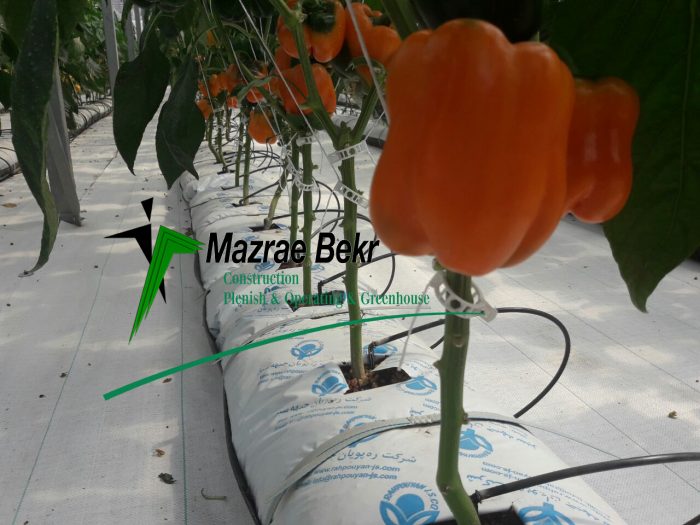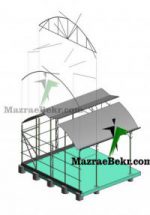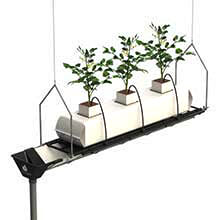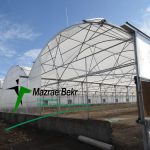Capsicum colored greenhouse sweet pepper
Green pepper is one of the most widely consumed vegetables in Europe and America, which is eaten raw or cooked in various colors and flavors, and has about 12 times more vitamin C than oranges. Greenhouse crops such as colored peppers, which grow slowly, have more fruit than other greenhouse crops such as tomatoes, cucumbers, and eggplants.
Modern technology greenhouses use high temperatures and extensive climate control to optimize the growing environment. In such conditions, pepper grows with high speed and efficiency. In the greenhouse environment, more productive pepper species are used to produce more fruit in the long run.
The growing pepper has two stems and when it grows larger it will have four stems. Peppers with two stems are more flexible under warmer conditions.
In simpler greenhouses with less control over weather conditions, peppers are more stressed. Stressful conditions reduce the strength of the pepper plant, so in this situation, you should choose a type of pepper that is resistant to these stresses.
The height of the green bell pepper plant is short and its fruit grows in three colors: red, yellow and orange. The red color of pepper is related to the alkaloid capsaicin.
Spanish structure with suitable equipment for soil cultivation is 16 $ to 25& per square meter.
Spanish greenhouse with equipment and substrate suitable for hydroponic cultivation is 26.8 $ to 51.8 $ per square meter.
Cultivation of greenhouse colored bell peppers
Temperatures between 15 to 35 degrees Celsius are suitable for the growth and development of greenhouse colored bell peppers, and if the temperature rises above 35 degrees, the flowers will fall and burnt spots will be seen at the tip of the fruit. Lowering the temperature below 15 degrees causes the buds and leaves of bell peppers to fall off and root rot to occur. The most suitable temperature during the day is between 18 to 30 degrees and at night 16 to 18 degrees. In general, the appropriate temperature for vegetative growth is 21 to 23 degrees and for reproductive growth is less than 21 degrees Celsius.
Light is very effective in growing green bell peppers and the amount of supplementary light required per day for 16 hours at a rate of 125 micromoles per square meter per second, which increases crop yield and early ripening of pepper fruit. Be. The amount of carbon dioxide required is around 1000 to 1500 ppm The best relative humidity of the greenhouse is about 75 to 80%. Increasing or decreasing the humidity causes the spread of fungal and bacterial diseases as well as the fall of flowers. The best pH required for peppers is about 7.
Production of greenhouse bell pepper by transplanting method is higher than direct seed cultivation method. Freshly harvested young pepper seeds are dormant for up to 6 weeks, after which the conditions are right for germination. Zero germination of the plant is equal to 9.10 degrees Celsius and seed germination occurs at temperatures below 25 degrees. Freshly harvested seeds can germinate for 2 to 3 weeks at 24 ° C for 20 days.
The depth of pepper seed cultivation in the treasury is between 1.5 to 2 cm and seed sowing is done in late November. Pepper seeds should start to germinate in about 7 to 10 days. The duration of seedling preparation usually varies between 10 to 12 weeks. Seeds are planted in the nursery among peat moss at a temperature of 25 to 26 degrees. Seed storage increases germination by 40 to 70%. The time of transplanting the seedlings to the main ground is when the first flower buds appear. After 10 weeks from the time of sowing the seeds in the seedling tray, the seedlings are transferred to the pot.
The soil EC should be about 2.5 micromoles per centimeter and after transferring the seedlings, the ambient temperature should be reduced to 21 degrees and the seedlings should be irrigated every two days. When transplanting seedlings to the greenhouse, the pepper plant should have about 6 to 7 leaves. The number of pepper plants per square meter reaches 2 to 3.5 plants. Less and more density will reduce the performance and quality of the product.
Deep planting of seedlings until the growth of the first true leaf after 30 days increases the dry matter and the number of flowers in the pepper plant. The substrate should be moist during transfer and nutrient solutions should be added to the main soil about one day before planting. The temperature of the main culture medium is kept constant between 20 and 21 degrees. The ambient humidity is set at 75 to 80% and the amount of carbon dioxide should reach 800 to 1200 ppm.
It usually takes 22 weeks from the time of flowering to the color of the fruit in the greenhouse bell pepper, and it takes 6 to 10 weeks from seedling to harvest. Harvesting is usually done once a week and sometimes up to 3 times. Harvesting is done when 85% of the fruit color is complete. Harvest is done 7 to 12 times during the growing season. The yield of greenhouse colored bell peppers per unit area is between 5 to 6 kg per square meter. Larger peppers are more marketable and are harvested with a sharp knife. Colored peppers can be stored at a temperature of 7 to 8 degrees and green peppers at a temperature of 10 degrees and a relative humidity of 90% and will harden as the fruit loses moisture.

Close the green bell pepper plant
Unlike cucumber and tomato plant, greenhouse colored bell pepper plant is not pulled down, but depending on the useful height of the greenhouse, two to three branches can be selected and tied to the end of each sub-branch and tied like the main branches. Wrap around the threads because at the end of the plant period, if healthy, it will grow to the useful height of the greenhouse. In the cultivation of colored peppers, like any other culture, there is a deficiency in the growth of the plant, which is good to know so that we can better solve the problems.
Deformation of the fruit occurs when the temperature after flowering has not been suitable for the plant for a long time and has been at 14 degrees Celsius. It should be noted that in the cold winter months, this problem also occurs for the plant. There is another cause of the complication and that is the presence of banana insects on the plant. These insects usually suck the sap of the plant and cause the fruit to deform. If the humidity of the greenhouse reaches 85%, or when the air in the greenhouse is cold and hot at night, or if irrigation starts late during the day, the fruit of the pepper plant will thicken and eventually split in two. When the fruit is the right size. But does not change color. The average temperature during the day is low. It is better to increase the average by at least half a degree.
Separation of the fruit from the plant before full ripening: This complication may occur in the first period and the cause is related to the primary leaves that are still small and cannot produce enough nutrients. Fixed a defect. In constructing a greenhouse of colored green pepper and setting up a successful greenhouse, it is necessary to pay close attention to the type and specifications of the greenhouse structure and its cover and equipment. In hydroponic cultivation of greenhouse colored bell peppers, Iranian and Spanish greenhouses with a minimum height of 5 meters and resistant to wind and snow in the region and crop weight are suitable.
Mazre Bekr Company, the structure of Spanish and Iranian greenhouses according to the topography, climate and prevailing weather conditions, soil type of each region, etc., as well as these greenhouses in accordance with 76UNE -92/208, 284CEN / TC and 57NFU- standards. 063 and the regulations of Iran, NGMA, USA and ECMC (European Union of Steel Structures) are designed with the best and most durable materials and provide the most economical structure. These green bell peppers are in different designs up to 110 kg / m2 Snow load and 120 km / s wind speed (provided the valves are closed) and 20 kg / m2 are product load resistant.
Harvest Greenhouse colored bell peppers
When green peppers are harvested, the greenhouse lasts longer than mid-summer to mid-autumn, depending on whether green or red is in demand. Sweet pepper cultivars when harvested. Their fruits are still green but must be fully grown. Green peppers can be stored in tall plastic bags at 8 to 10 ° C and 85% relative humidity for 4 weeks.

Export of bell peppers
One of the main problems in the export of sweet pepper products, which has caused Iran to not be able to find its place among other competing countries in the field of global competition.
– Variable export laws
– High cost of the product compared to foreign competitors
– Improper distribution of conversion industries due to the center and pole of agriculture,
– Significant Worn out on the machinery part of production units
– Weakness in packaging
– Exporters are not familiar with export markets

Contact us to build a green bell pepper greenhouse.
Other Keywords: Sweet Pepper Greenhouse, Summer Greenhouse, Colored Pepper, Suitable Greenhouse, Suitable Greenhouse for Colorful Green Pepper, Greenhouse Maker Khorasan, International Greenhouse Builder in Iran, Green Pepper Greenhouse in Iran, Construction of Green Pepper Greenhouse, Green Pepper Greenhouse, Color Pepper Greenhouse Builder, Modern Greenhouse Construction, Best Greenhouse Sweet Pepper Cultivation, Greenhouse Sweet Pepper Cultivation Training, Greenhouse Sweet Pepper Seed, Necessary Colorful Pepper Facilities, Greenhouse, Standard Greenhouse, Greenhouse bell peppers, how to grow summer crops, comprehensive information on greenhouse bell peppers, all about greenhouse bell peppers, green bell peppers, suitable pepper structures, green bell peppers, modern greenhouse bell peppers, greenhouses Pepper in Iran, a consultant for growing colored bell peppers.











